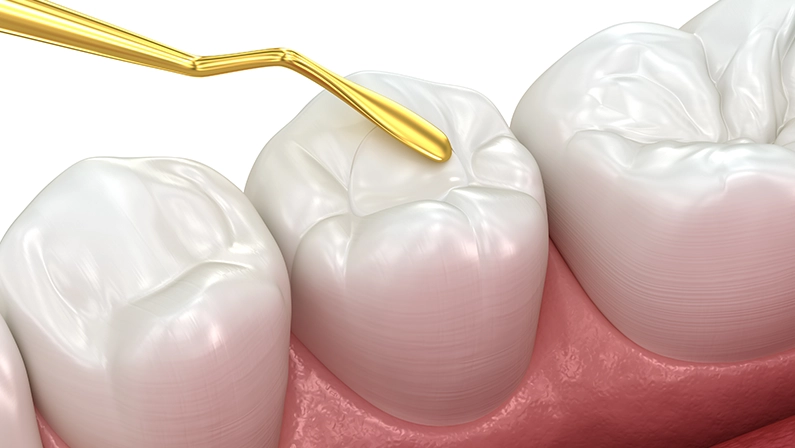Dental fillings are a common and effective solution for restoring teeth damaged by decay, cracks, or minor fractures. They help alleviate pain and discomfort and also prevent further damage by sealing the affected area.
With advancements in dental technology, fillings today are more durable and aesthetically pleasing than ever before, offering a seamless blend with your natural teeth. Whether you’re dealing with a cavity or need to replace an old filling, understanding the process and materials available is key to making an informed decision about your oral health.
What are dental fillings?

Dental fillings are materials used to restore teeth damaged by cavities or decay. They help seal the affected area, preventing further damage while restoring the tooth’s shape and functionality. Commonly performed by restorative dentists, this procedure is essential for maintaining oral health and preventing tooth loss.
What are the steps involved in filling a tooth?
Understanding the steps involved can help alleviate any concerns. From the initial examination to the final polishing, here’s a breakdown of each step in the dental filling process.
Initial Examination
The process begins with a thorough examination to determine the extent of decay. X-rays may be used to identify hidden cavities and ensure a precise diagnosis.
Decay Removal
Once diagnosed, the dentist removes the decayed portion of the tooth using specialized tools. This step is critical for preventing the decay from spreading further.
Cleansing
After decay removal, the cavity is cleansed to remove debris and bacteria. This ensures the area is sterile and ready for the filling material.
Filling
The chosen filling material is applied in layers. Depending on the material, each layer is carefully shaped and hardened using a special light or chemical process.
Final Check & Polishing
Finally, the dentist checks the filling to ensure it aligns with your bite. Once verified, the surface is polished for a smooth and natural finish.
What are the types of dental filling materials used?
Choosing the right dental filling material depends on your needs, preferences, and budget. Each type of filling offers unique benefits in terms of durability, appearance, and functionality. One common question patients ask is, “How long do dental fillings last?” The answer varies depending on the material used and proper oral care, with some fillings lasting over a decade.
Gold Fillings
Gold fillings are a classic and highly durable choice, often regarded as one of the best materials for long-term dental repairs. Gold is biocompatible, meaning it integrates well with your body and is corrosion-resistant, making it a great option for long-lasting results. Gold fillings are particularly useful for molars or back teeth, where the filling will endure significant chewing pressure.
On average, gold fillings can last 15 years or more with proper care, which is why many patients consider them a worthwhile investment despite their higher costs.
Amalgam Fillings
Amalgam fillings are made from a mixture of metals, including silver, mercury, tin, and copper. Known for their strength and longevity, these fillings are often used in the back teeth, where durability is a top priority. While not as aesthetically pleasing as other filling materials due to their silver-gray color, they are among the most affordable and long-lasting options.
With proper maintenance, amalgam fillings can last around 10-15 years, although some patients may prefer more discreet options, especially for visible teeth.
Composite Fillings
Composite fillings, made from a mixture of plastic resins and glass particles, are a popular choice for those who prioritize aesthetics. These fillings can be custom-colored to blend seamlessly with the natural shade of your teeth, making them an excellent choice for front teeth or areas visible when smiling.
Typically, composite fillings last 5 to 10 years, depending on the size of the cavity and how well they are maintained. Composite materials also bond directly to the tooth structure, providing additional strength and support.
Glass Ionomer Fillings
Glass ionomer fillings are made from a blend of acrylic and glass, offering slightly different benefits. One key advantage of glass ionomer fillings is that they release fluoride, which helps prevent further decay in the surrounding tooth.
These fillings are often used in children’s teeth or in areas where less pressure is applied, such as along the gum line. On average, glass ionomer fillings last around 5 to 7 years, though they may wear down quicker than composite or amalgam fillings.
What are indirect fillings?
Indirect fillings, such as inlays and onlays, are custom-made in a dental lab and used when the tooth structure is insufficient for a traditional filling. They are bonded to the tooth, offering a durable and aesthetic solution.
What are temporary fillings?
Temporary fillings are used as a short-term solution to protect a tooth while awaiting a permanent filling or other dental treatments. They are commonly placed when a cavity is too large or complex to be treated in a single visit or when a dentist needs time to assess the tooth further before choosing the best treatment option.
Temporary fillings can also be used if a permanent filling is unavailable during an emergency situation, providing immediate relief until a more permanent solution is implemented.
How do I know if I need a dental filling?

Common signs you may need a dental filling include:
- Sensitivity to hot or cold foods.
- Pain when biting or chewing.
- Visible holes or dark spots on the tooth.
- Food frequently gets stuck in a specific area.
How long does it take to recover after a dental filling procedure?
Recovery after a dental filling is typically quick, with most patients resuming normal activities the same day. Minor sensitivity to hot, cold, or pressure may last a few days. If discomfort persists, consult your dentist.
Does getting a dental filling hurt?
A common question is, “Is dental filling painful?” The procedure is generally painless due to local anesthesia. Post-procedure sensitivity may occur but usually subsides quickly.
Need an emergency dental filling? Call Brownstone Dental Today

When it comes to dental fillings, the material used can make a significant difference in both the durability and appearance of the restoration. Choosing the right material depends on various factors, such as the location of the filling, the size of the cavity, and personal preference. Understanding your options ensures that you make an informed decision for both functionality and aesthetics.
Whether you’re asking which type of tooth filling is best for you or have concerns about the pain involved in the procedure, Dr. Saif Shere, DMD, at Brownstone Dental in Houston, TX, can guide you through your options. Book your appointment today and experience the best dental fillings in Houston!